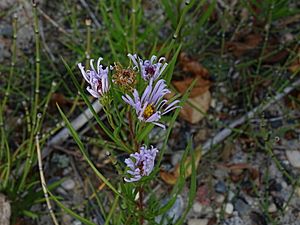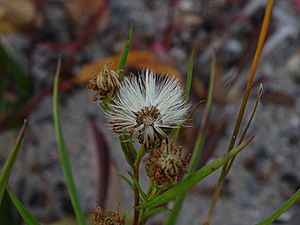Robyns's aster facts for kids
Quick facts for kids Robyns's aster |
|
|---|---|
 |
|
| Conservation status | |
| Scientific classification | |
| Genus: |
Symphyotrichum
|
| Species: |
robynsianum
|
| Synonyms | |
|
|
Symphyotrichum robynsianum is a type of flowering plant. It's also known as Robyn's aster or long-leaved aster. This plant belongs to the Asteraceae family, which includes daisies and sunflowers. You can find it growing naturally in parts of northeastern North America.
What Does Robyn's Aster Look Like?
Robyn's aster is a perennial plant. This means it lives for more than two years. It's also a herbaceous plant, so it has soft, green stems instead of woody ones like trees. It grows from long underground stems called rhizomes. These rhizomes help the plant spread.
Its main stems stand straight up and can be anywhere from 10 to 80 centimeters (about 4 to 31 inches) tall. The leaves are narrow and stiff. They might have small teeth along their edges or be completely smooth.
This plant usually blooms from August to September. Its flower heads can appear alone or in small groups of up to three. Each flower head looks like a single flower, but it's actually made of many tiny flowers. The outer "petals" are dark blue-violet. These are called ray florets. The center part of the flower head is made of yellow disc florets.
Naming Robyn's Aster: How Scientists Classify It
For a long time, Symphyotrichum robynsianum was part of a larger group of plants called Aster. It was known as Aster robynsianum. However, scientists later found that the Aster group was too broad. It included plants that weren't closely related. This is called being "polyphyletic".
Because of this, many North American asters, including Robyn's aster, were moved to a new group called Symphyotrichum. There are no smaller groups, like subspecies or varieties, recognized within Symphyotrichum robynsianum.
This plant was sometimes mistakenly called Aster longifolius. But that name actually belongs to a different plant, the New York aster (Symphyotrichum novi-belgii).
In 1957, a Canadian scientist named Jacques Rousseau described Aster robynsianum. He named it after Walter Robyns, who was a director at the National Botanic Garden of Belgium. Later, in 1997, two other scientists, Luc Brouillet and Jacques Labrecque, first used the name Symphyotrichum robynsianum.
Scientists think that Symphyotrichum robynsianum might have started as a mix between two other aster species. But its exact origin is still a bit of a mystery.
Where Does Robyn's Aster Grow?
Symphyotrichum robynsianum is native to several areas in North America. You can find it in the Canadian provinces of Manitoba, Ontario, and Quebec. It also grows in the U.S. states of Michigan, Minnesota, and Wisconsin.
This plant likes places that are moist and open. It often grows in sandy, gravelly, or rocky areas. You might see it along the shores of rivers and lakes. It also grows in special habitats called alvars. These are open areas with thin soil over limestone bedrock. Robyn's aster usually prefers habitats that have a lot of calcium, like those with limestone.



